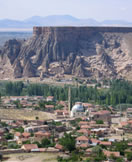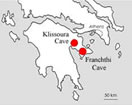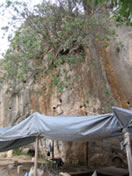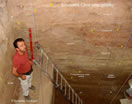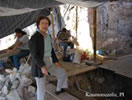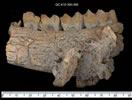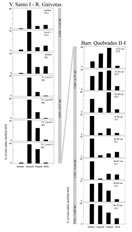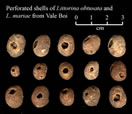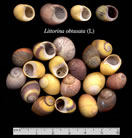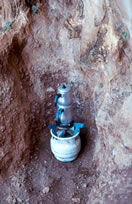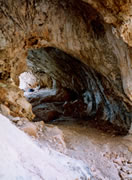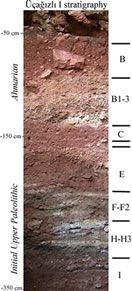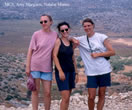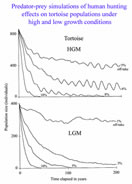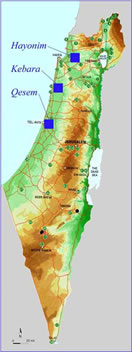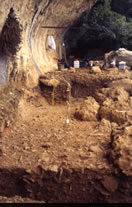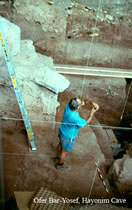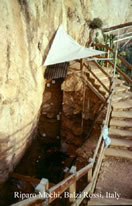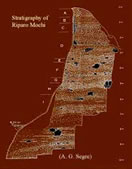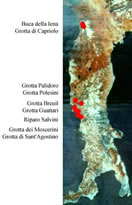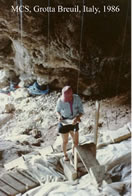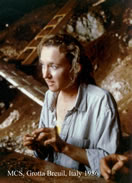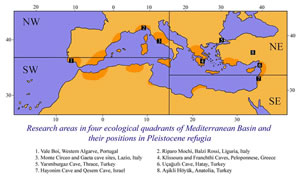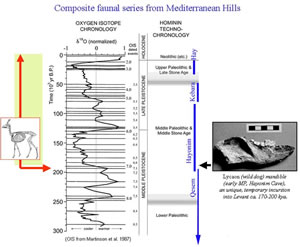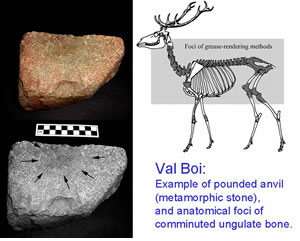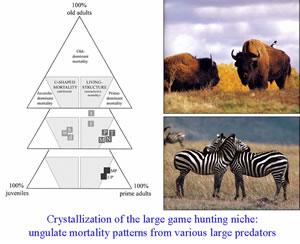RESEARCHING PALEOLITHIC DIET, PREDATOR-PREY DYNAMICS AND ECOLOGY ACROSS THE MEDITERRANEAN BASIN
| | Asikli Höyük, Turkey | Franchthi Cave, Greece| |
| | Klissoura Cave 1, Greece | Qesem Cave, Israel | |
| | Vale Boi, Portugal | Hatay coast, Turkey| |
| | Hayonim Cave, Israel | Yarimburgaz Cave, Turkey | |
| | Riparo Mochi, Italy | Grotta Breuil, Italy | Pietra, Italy | |
— • —
The evolution of humans is intertwined with long-term changes in climate and ecology. Yet questions about causal links among these natural processes continue to elude Paleoanthropologists to a large extent. This is the case even in the Mediterranean Basin, where everyone agrees that humans have exerted strong effects on environments and biotic communities since early times.The Mediterranean Basin forms the geographic hub for the African and Eurasian continents, and many chapters of human cultural evolution have played out along its margins. At times, the boundaries of these Old World continents were synonymous with the boundaries of biotic zones and their constituent species. Continental boundaries became irrelevant for species distributions in other periods, however, when the sea mediated coastal climates to a greater extent, along with global climate processes. Biotic refuges represent another theme in Mediterranean paleoecology, persisting throughout the basin during the Pleistocene, such as in the northern Levant, Cyrenaica in North Africa, Aegean Turkey, and Algarvian Portugal.
Archaeological evidence tells us that the timing of many important shifts in early cultures varied by region within the Mediterranean region. Some of these changes parallel climate change, whereas others appear quasi- or wholly independent of climate effects. Many precocious cultural developments such as the earliest Upper Paleolithic and diet expansion seem to have emanated from the east (Stiner 2002; Stiner and Kuhn 2006). Testing these and other evolutionary trends requires huge, internally consistent data sets that represent great spans of time. While many zooarchaeologists have collected important data on Paleolithic subsistence and made them available via publication, the questions I am asking of the data demand rigid and rather specific standards for sample quality and size. This is too much to expect of a literature representing several decades of research driven by highly varied agendas.
Working in small teams or nested within international projects, we continue to build several "deep time" faunal series that collectively span 400,000 to 8,000 years ago. These faunal series represent distinct ecogeographic quadrants of the Mediterranean Basin. Many of my recent activities are about filling the gaps in these faunal series, such as the late Lower Paleolithic in Israel, and the Initial Upper Paleolithic and late Middle Paleolithic in Turkey. Locality is held as constant as possible in each geographic quadrant in an attempt to narrow the potential causes of cultural variation (Stiner et al. 2000). This strategy allows us to clarify the timing and geographic centers of subsistence stress and rapid population growth during the Pleistocene, and to distinguish these from other factors that contributed to behavioral transitions during the Paleolithic and Neolithic.
2008-current. Senior collaborator for zooarchaeology and site formation processes at the Pre-Pottery Neolithic site of Asikli Höyük in Anatolia, Turkey . The main foci of this international project are site formation processes, diet and architectural evolution of the early (pre-ceramic) Neolithic and of the forager societies that immediately preceded it. Asikli Höyük was extensively by Prof. Ufuk Esin of Istanbul University over many years, exposing deep trench profiles and providing access to the earliest layers. Work has begun anew at Asikli Höyük under the leadership of Prof. Mihriban Özbasaran (Istanbul University) and will explore the earliest archaeological layers along with faunal, geochemical and micromorphological studies of the entire sedimentary sequence. Stiner helps to coordinate international research collaborations on the geoarchaeology, faunal and botanical records, particularly as they pertain to the spatial structure of human activities and dietary change. A comprehensive plan for conservation and protection of the site is also underway. 2006-current. Collaborating analyst of the faunas from Franchthi Cave, Greece . This research project is a collaboration between Dr. Natalie Munro (PI, University of Connecticut-Storrs) and Stiner (co-PI), and investigates human socio-economic change across the 30,000 year faunal record of Franchthi Cave in the eastern Peloponnese of southern Greece. Franchthi Cave was excavated in the 1960s and 1970s by a large team from the Universities of Indiana and Pennsylvania (USA) and the American School of Classical Studies at Athens. Thorough recovery procedures yielded an enormous collection of well preserved bone specimens, yet only parts of the Franchthi assemblage have been studied and all of the studies of the vertebrate remains have been of a preliminary character and are lacking taphonomic observations. The Franchthi faunal series is unique for its long temporal span that includes horizons leading up to and including the Neolithic transition in the region. Greece was one of the first areas into which farming economies expanded from the Near East. Previous work on the faunas revealed remarkable shifts in the sources of animal protein, emerging with a typical focus on large hoofed animals in the Aurignacian, overtaken by the rising importance of smaller prey, and, by the Mesolithic, fishing for pelagic and demersel species along with marine shellfish. A comprehensive study is planned for the next 4 years. The economic trends are being examined with new eyes from the perspectives of foraging theory and population ecology. 2005-2010. Senior analyst and PhD advisor on Paleolithic vertebrate, mollusk and ornament faunas of Klissoura Cave 1, Greece. This research is a collaboration with Britt Starkovich (UA) and Drs. M. Koumouzelis and P. Karkanas, Ephoreia of Palaeoanthropology-Speleology, Athens, and Prof. Janusz Kozlowski of Jangiellonian University in Krakow, Poland. A complete analyses of the vertebrate faunas from taphonomic and economic perspectives is the topic of Starkovich's PhD dissertation on the Middle and Upper Paleolithic vertebrates from Klissoura cave 1, in collaboration with Teresa Tomek, Piotr Wojtal and others of the Polish Academy of Sciences-Krakow, Poland. The purpose of this study is to understand changes in animal exploitation strategies from the Middle through Upper Paleolithic and Mesolithic, focusing on both large and small-game utilization. Klissoura Cave 1 contains the longest, most complete early archaeofaunal series that has been excavated in Greece. It also contains rich ornament assemblages dating to the early Upper Paleolithic and later periods and is being studied by Stiner. Decorative traditions, including personal ornaments, are considered to be an important indication of the emergence of modern human behavior in the Paleolithic. Ornament repertoires are well known from the site of Franchthi cave, but little information currently is available for the early Upper Paleolithic. The Aurignacian ornament assemblages from Klissoura Cave 1 associate with hearth and structural features and provide insights about the contexts of raw material procurement, ornament use and discard.
2003-2010. Sole faunal analyst and taphonomist, Lower Paleolithic faunas, Qesem Cave, Israel . Qesem Cave was discovered in 2001 during road expansion works west of Tel Aviv. This collaboration wi th Professors Ran Barkai and Avi Gopher of Tel Aviv University focuses on a long Acheulo-Yabrudian cultural sequence spanning 200-400,000 years before present, the technology of which is largely or exclusively Amudian in character. The sediments contain abundant faunal remains, and although the formation history complex, and the bones highly fragmented, they are in good condition and bear many indications of hominid activity. Evidence of fire is widespread in the upper layers and promises new information on the early evolution of fire technology in the Lower Paleolithic. Here, hominid foraging activities centered on large game, supplemented by tortoises in low numbers. The deer assemblages provide some of the earliest known examples of prime-age-focused hunting, a predator-prey relationship that became typical by the Middle Paleolithic and onward. Jessica Rowland et al.'s (UA, Geosciences MA project) companion study of stable isotope values ( d 13 C, d 18 O) of gazelle and fallow deer bioapatite from this and other Levantine caves in the Mediterranean Hills region-Qesem Cave, Hayonim Cave and Meged Rockshelter-indicates consistent niche separation between Dama and Gazella once the latter species penetrated the region ca. 200,000 years ago, in spite of increasing aridity and other climate fluctuations. The introduction of gazelles to the herbivore guild was abrupt. Subsequent increases in gazelles in archaeofaunas of the region may signal an expansion of open land habitats, fragmentation of Mediterranean forests, and perhaps intensified cycles of fire disruption as aridity increased.
1998-2002. Sole faunal analyst for research on Mesolithic shell middens, Algave region of southern Portugal . The first occasion of Stiner's research in Portugal focused on the nature of the Mesolithic-Neolithic economic transition in Algarve based on coastal shell midden faunas, in collaboration with Prof. Nuno Bicho of the University of Algarve. Marine shellfish were major sources of animal protein and food energy in the region prehistorically. The lack of change in the relative abundance of productive grazing and suspension-feeding intertidal mollusks to slow-growing large drills in the archaeofaunal assemblages suggests, however, that no additional pressure was placed on marine resources from the late Mesolithic to the time when ceramics first appear (early Neolithic) in this study area, in contrast to some other areas of Portugal and Spain.
1999-2004. Initial analyst and, later, PhD advisor for zooarchaeological research on the Paleolithic faunas of Vale Boi, Algarve, Portugal. Prior to the discovery of the Upper Paleolithic site of Vale Boi, the Paleolithic of the Algarve in southern Portugal was a virtual terra incognita. Several years of excavation and faunal study collaboration with Prof. Nuno Bicho (University of Algarve) and Tiina Manne (UA PhD student) reveal a varied meat diet that combined large game, marine shellfish and/or small mammals. The artifactual assemblages include diagnostic lithics, osseous tools, and ornaments made mainly from small Littorina shells that date to the Gravettian, Solutrean and Magdalenian phases of the Upper Paleolithic. An initial study by Stiner revealed the likelihood of grease rendering of large game carcasses from the Gravettian onward, based on the co-occurrence of abundant fire-cracked rock, stone anvils, and highly fragmented spongy bone. Few if any other examples dating to the Gravettian are known as yet, possibly due to generally poor recognition of carcass processing techniques in archaeofaunal records or there was exceptionally early selection for this economic behavior at the southern fringe of the Iberian peninsula. The coupling of heavy rabbit exploitation and grease rendering of ungulate prey with the Gravettian of Algarve is intriguing. Grease rendering can be difficult to prove, however, and evaluation of this and other economic questions requires an integrated analysis of site formation processes as well as faunal variation, the subjects of Tiina Manne's (UA) dissertation.
1997-2008. Senior faunal analyst and taphonomist, Upper and Middle Paleolithic faunas, Üçagizli Caves I and II, Hatay coast, Turkey. A decade of excavation in Üçagizli Caves I and II in the Hatay region of Turkey in collaboration with Prof. S. Kuhn (U. Arizona) and Prof. Erksin Güleç (Ankara University, Turkey) has yielded abundant, well preserved faunas representing the Middle Paleolithic, Initial Upper Paleolithic and Ahmarian culture periods. A minor Epipaleolithic component is also present. The zooarchaeological component of this long-term project considers all vertebrate and mollusk remains from representing Paleolithic food refuse, along with small mollusks used as ornaments. Manufactured on local shell material, the ornament assemblages from the Initial Upper Paleolithic are among the earliest known in Eurasia. Some trends in prey exploitation at this site echo patterns that have been documented elsewhere in the Mediterranean Basin, but other details of this faunal series appear to be unique to the northern Levant. A companion PhD study conducted by Dr. Aysan Açikkol (now at Sivas University in Turkey) tracks trends in ungulate body size through these periods. Pan-Mediterranean comparisons of diet breadth expose a major shift in human predator-prey dynamics involving small game animals by 50-40 KYA, with earliest indications occurring in the Levantine corridor based on new evidence from Üçagizli I and II Caves and sites in the Galilee of Israel.
1999-current. Laboratory experiment program in bone decomposition, burning, boiling, and diagenesis, at the University of Arizona , Tucson . A long-standing program of experiments conducted by Stiner and students at the University of Arizona explores patterns of bone alteration and dispersion that may arise from prehistoric methods of processing food, foot traffic, domestic space use, and the macro- and micro-structural decomposition. These experiments have been over more than a decade in collaboration with UA graduate students (e.g., Amy Margaris [now at Oberlin College], Todd Surovell [now at U. Wyoming], Tiina Manne, and Susan Mentzer). Early themes for experimentation centered on burning effects, mineral diagenesis, and fragmentation. Students' research designs now dominate the program. Recent experiments focus on defining the archaeological signatures of intensive carcass processing including grease rendering, use of bones as fuel, and human versus geologically driven fragmentation processes. The assemblages produced by the experiments are analyzed using zooarchaeological methods, micromorphological analysis of prepared thin-sections, and infrared spectroscopy (FTIR). The research continues to teach us a great deal about how bone mineral diagenesis affects the quantification of archaeofaunal records.
1998-2007. Predator-prey computer simulation modeling of hunting sustainability for prey animals commonly eaten by prehistoric humans, a research program conducted at the University of Arizona , Tucson . This research began in the late 1990s with the problem of interpreting prey diminution and harvesting pressure on tortoises in Levantine Paleolithic sites. Two generations of simulation study have been completed to date in collaboration with UA Anthropology graduate students: The first generation was undertaken with Todd Surovell (now faculty at U. Wyoming) and Natalie Munro (now faculty at U. Connecticut-Storrs) and focused on differential population recovery of three major types of small game, each with very different development rates-tortoises, lagomorphs and game birds (partridges). The second generation of modeling work instead focuses on predator effects and prey choice for artiodactyl; these are prey animals with comparatively similar growth rates but very different body masses. This study was done collaboration with Joseph Beaver (now adjunct faculty at U. Minnesota-Morris). The modeling projects are conceptual explorations of forager predator-prey dynamics and possible implications for changes in human population densities during the Middle and Late Pleistocene. 1992-2003. Sole faunal analyst and taphonomist, Middle and Upper Paleolithic faunas in Galilee site, Hayonim Cave, Israel, in collaboration with project co-PIs, Prof. Ofer Bar-Yosef (Harvard University), Dr. Liliane Miegene (CNRS, France), and other researchers . 1994-1997. Sole faunal analyst and taphonomist, Upper Paleolithic (early Kebaran) faunas in Galilee site, Meged Rockshelter, Israel , in collaboration with Prof. Steven Kuhn (UA) and Prof. Anna Belfer Cohen (Hebrew University) . The zooarchaeological work on these projects lasted nearly a decade (1992-2001) and focused on Middle through Epipaleolithic human ecology in the central Levant region. Close collaborators in this work were the late Prof. Eitan Tchernov (Hebrew University), an expert on micro-mammal turnover and paleoecology, and Prof. Stephen Weiner (Weizmann Institute of Science), an expert in geochemistry, structural biology and bone diagenesis. The approaches taken in this study integrated data on sediment chemistry, population ecology, human behavioral ecology, predator-prey computer simulation modeling, paleontology, biogeography, and paleoanthropology. 1992. Zooarchaeological and taphonomic analyses of Middle Pleistocene faunas from Yarimburgaz Cave, Turkey. This large cave is located just west of the city of Istanbul. Middle Pleistocene deposits containing well-preserved faunas rich in bear bones were found alongside late Lower Paleolithic (and possibly LP-MP transitional) artifacts below Chalcolithic and Byzantine horizons. The Middle Pleistocene deposits were excavated by a team led by Prof. Guven Arsebuk (Istanbul University) and the late Prof. F. Clark Howell (U. California-Berkeley) from 1988-1990. The Middle Pleistocene layers date to roughly 250-300,000 years ago. The site poses a complex, time-averaged puzzle in which cave bear and human occupations were superimposed, and Stiner was invited to join the project in 1992 to address these questions. 1991-1992. Analysis of mammal, shellfish, and ornament collections from Riparo Mochi, Italy. Riparo Mochi is one of the larger shelters in the Grimaldi cave complex in the Balzi Rossi of Liguria. Riparo Mochi was the subject of excavation over nearly two decades (late 1930s through 1950s) by Prof. A. C. Blanc and Luigi Cardini, and other members of the Istituto Italiano di Paleontologia Umana. It preserves a 9 m stratigraphic cultural sequence spanning an undated Middle Paleolithic through Upper Paleolithic and Epipaleolithic layers. The quality of bone, shell, and lithic recovery of the Upper Paleolithic and later materials was exceptional, permitting detailed study of the ornaments and game use. The Mousterian faunal collections from the site are limited, possibly due to poor preservation, since the lithic collections are large. Riparo Mochi provides a detailed record of Paleolithic subsistence and diet diversification from the earliest Aurignacian in the region through the late Epigravettian. 1987-1994. Project co-director and faunal analyst for excavations at the Middle Paleolithic cave site of Grotta Breuil , Italy . The Grotta Breuil excavations on Monte Circeo began in the mid 1980sunder the leadership of the late Prof. Amilcare Bietti of the Università di Roma. This cave contains a deeply stratified Late Pleistocene Mousterian sequence with well-preserved faunas in most layers except for those at the base. This excavation project provided important data on late Middle Paleolithic hunting behavior in Italy for Stiner, Francesca Alhaique, and others, and valuable contextual information on preservation chemistry and site formation processes for caves in the west-central Italian study area. 1987-1991. Taphonomic and zooarchaeological study of Lower Paleolithic open sites of Fontana Ranuccio (Anagni Basin) and Torre in Pietra, Italy. These are two excavation projects run by members of the Istituto Italiano di Paleontologia Umana, Roma. Stiner conducted studies of taphonomic history, species, and body part contents of these late Middle Pleistocene faunas associated with late Acheulean or transitional Lower-Middle Paleolithic industries. Though the work remains unpublished, the sites provided Stiner with valuable reference data on late Middle Pleistocene open sites in lake and stream environments.
1985-1990. Dissertation research on Late Pleistocene faunal collections from cave and shelter sites of west-central Italy (Provinces of Latium and Tuscany): Grotta Guattari, Grotta dei Moscerini, Grotta di Sant'Agostino, Grotta Breuil, Grotta di Capriolo, Buca della Iena, Riparo Salvini, Grotta Polisini, and Grotta Palidoro . This large study was based principally on faunal collections of the Istituto Italiano di Paleontologia Umana, Università di Roma, Museo Pigorini, Museo A. C. Blanc in Viareggio, and the Università di Pisa. The research was conducted following the predictions of niche theory concerning the long-term outcomes of inter-specific competition among ungulate predators-Paleolithic humans, spotted hyenas, and wolves-during the Late Pleistocene. Many of the techniques essential to Stiner's subsequent research on subsistence and taphonomy in other Mediterranean regions were first developed for this Italian collections research project.
1988. Faunal analysis of Hubbell Trading Post, New Mexico, historic collections.
1986. Faunal analysis of Low Mountain, Arizona, Basketmaker sites, for Bureau of Indian Affairs.
1986. Crew supervisor, Piedras Marcadas Arroyo Survey, New Mexico, for City of Albuquerque and State Historic Preservation Division.
1986. Project coordinator, Calabacillas Arroyo Survey, New Mexico, for City of Albuquerque and State Historic Preservation Division.
1985. Crew supervisor, West Mesa Petroglyph Inventory Survey, New Mexico, for City of Albuquerque and State Historic Preservation Division.
1985. Faunal analyst, historic faunas from Old Pueblo Refuse Mound (NM:12:K3:1) and the Benito Yamutewa House (LA9093), Pueblo of Zuni, New Mexico, for Zuni Archaeology Program.
1984. Field crew member, Chaco Culture National Historical Park Inventory Survey, New Mexico, for Division of Cultural Research (Chaco Center).
1983. Field crew member on the Abri Dufaure excavation, France, an Upper Paleolithic rockshelter in southern France, directed by L.G. Straus, University of New Mexico.
1981. Crew supervisor and teaching assistant, University of Delaware Summer Field School, Delaware.
| Back to Top |

